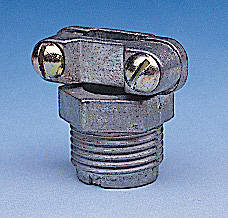RF lighting
Well lets review the situation

.
If I have understood your example correctly you are using a short length of conduit, earthed via the surface mounted box. This conduit is partly flush in the wall and as such comes with the scope of [522.6.6].
The purpose of the conduit is remove the need to apply additional protection as detailed in [522.6.7].
Similar solutions might be considered for [522.6.8].
Your example removes the diversion caused by having to consider whether the earth connection to the conduit is, or indeed needs to be, accessible for maintenance and inspection. So we should just consider whether additional protection is needed or not.
We are concerned about impact, in particular, impact that causes penetration of the wiring system. The danger that could result is that a nail or similar could make contact with a line conductor resulting in the nail becoming 'live' with respect to any simultaneously accessible exposed-conductive-parts or extraneous-conductive-parts - thus creating a risk of electric shock.
[522.6.6 (ii)] requires that if conduit is to be used as a protective measure it must be earthed. It also requires that it meets the requirements for a protective conductor.
It is important to note that the protection provided by this system does not seek to prevent penetration of the wiring system. Its function is to disconnect the supply to the affected circuit within a specified time should penetration occur.
This requires that:
1) the protective system is robust enough to maintain the faulty circuit until disconnection occurs;
2) the impedance of the faulty circuit is low enough to enable the operation of an overcurrent device within the specified time.
For 1) conduit that meets the requirements of BS 61386 is generally robust enough to carry the resulting fault current without failure (i.e. it is unlikely that it would vaporise and break the fault connection too early).
For 2) confirmation that circuit earth fault loop impedance is low enough at the surface box and, either by inspection or measurement, at the end of the conduit (female bush end).
I see no problems here as conduit to BS 61386 does meet the requirements of BS 7671 for a protective conductor. In addition, using earthed conduit to BS 61386 meets the requirements of [522.6.6 (ii)].
Now you may wish to ponder the following:
1) this method assumes that the fault caused by the nail is a 'dead short' (zero impedance);
2) this method does not offer any protection for neutral to earth faults;
3) if the conduit did vaporise and fail to maintain the fault connection the system will not offer any protection (an RCD might).
However, BS 7671 does not address these issues

.


